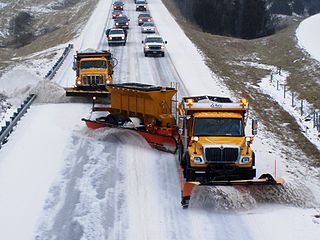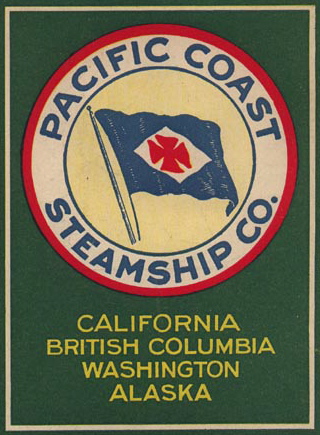
The Central Pacific Railroad (CPRR) was a rail company chartered by U.S. Congress in 1862 to build a railroad eastwards from Sacramento, California, to complete most of the western part of the "First transcontinental railroad" in North America. Incorporated in 1861, CPRR ceased independent operations in 1885 when the railroad was leased to the Southern Pacific Railroad. Its assets were formally merged into Southern Pacific in 1959.

America's first transcontinental railroad was a 1,911-mile (3,075 km) continuous railroad line built between 1863 and 1869 that connected the existing eastern U.S. rail network at Council Bluffs, Iowa, with the Pacific coast at the Oakland Long Wharf on San Francisco Bay. The rail line was built by three private companies over public lands provided by extensive U.S. land grants. Building was financed by both state and U.S. government subsidy bonds as well as by company-issued mortgage bonds. The Western Pacific Railroad Company built 132 miles (212 km) of track from the road's western terminus at Alameda/Oakland to Sacramento, California. The Central Pacific Railroad Company of California (CPRR) constructed 690 miles (1,110 km) east from Sacramento to Promontory Summit, Utah Territory. The Union Pacific Railroad (UPRR) built 1,085 miles (1,746 km) from the road's eastern terminus at the Missouri River settlements of Council Bluffs and Omaha, Nebraska, westward to Promontory Summit.

A rotary snowplow or rotary snowplough is a piece of railroad snow removal equipment with a large circular set of blades on its front end that rotate to cut through the snow on the track ahead of it. The precursor to the rotary snowplow was the wedge snowplow.

The Mount Gretna Narrow Gauge Railway was a 2 ft narrow-gauge line of the Cornwall and Lebanon Railroad in the state of Pennsylvania that operated between 1889 and 1915 under the parent Cornwall and Lebanon Railroad Company. The C&L Railroad earlier had established a station and picnic ground at Mount Gretna.

A snowplow is a device intended for mounting on a vehicle, used for removing snow and ice from outdoor surfaces, typically those serving transportation purposes. Although this term is often used to refer to vehicles mounting such devices, more accurately they are known as winter service vehicles, especially in areas that regularly receive large amounts of snow every year, or in specific environments such as airfields. In other cases, pickup trucks and front end loaders are outfitted with attachments to fulfill this purpose. Some regions that do not frequently see snow may use graders to remove compacted snow and ice off the streets. Snowplows can also be mounted on rail cars or locomotives to clear railway tracks.
"Public Ivy" is an informal term that refers to public colleges and universities in the United States that are perceived to provide a collegiate experience on the level of Ivy League universities. There is no trademark for the term, and the list of schools associated with the classification has changed over time.

Peter Voulkos was an American artist of Greek descent. He is known for his abstract expressionist ceramic sculptures, which crossed the traditional divide between ceramic crafts and fine art. He established the ceramics department at the Los Angeles County Art Institute and at UC Berkeley.

The Bridgton and Saco River Railroad (B&SR) was a 2 ft narrow gauge railroad that operated in the vicinity of Bridgton and Harrison, Maine. It connected with the Portland and Ogdensburg Railroad from Portland, Maine, to St. Johnsbury, Vermont, near the town of Hiram on the Saco River.

Francis Peloubet Farquhar was an American mountaineer, environmentalist and author. In his professional life, he was a Certified Public Accountant.

Ynés Enriquetta Julietta Mexía was a Mexican-American botanist notable for her extensive collection of novel specimens of flora and plants originating from sites in Colombia, Mexico, and Peru. She discovered a new genus of Asteraceae, known after her as Mexianthus, and accumulated over 150,000 specimens for botanical study over the course of a career spanning 16 years enduring challenges in the field that included poisonous berries, dangerous terrain, bogs and earthquakes for the sake of her research.

Black Mountain is a summit on Monte Bello Ridge in the Santa Cruz Mountains of west Santa Clara County, California, south of Los Altos and Los Altos Hills, and west of Cupertino; it is within the Palo Alto city limits though not near the developed part of the city. It is located on the border between Rancho San Antonio Open Space Preserve and Monte Bello Open Space Preserve, with the summit located in the former. Early Spanish explorers commonly named tree- or chaparral-covered summits which look black in the distance Loma Prieta, from the Spanish . The Spanish also called the middle portion of the Santa Cruz Mountains the Sierra Morena meaning, extending from Half Moon Bay Road south to a gap at Lexington Reservoir, and which includes a summit called Sierra Morena. There are over 100 "Black Mountains" in California.

Lucius Morris Beebe was an American writer, gourmand, photographer, railroad historian, journalist, and syndicated columnist.

Hillside letters or mountain monograms are a form of hill figures common in the Western United States, consisting of large single letters, abbreviations, or messages displayed on hillsides, typically created and maintained by schools or towns. There are approximately 500 of these geoglyphs, ranging in size from a few feet to hundreds of feet tall. Hillside letters form an important part of the western cultural landscape, as they function as symbols of school pride and civic identity.

The Carrabassett River, a tributary of the Kennebec River, is located in Franklin County and Somerset County, Maine, in the United States. It rises near Sugarloaf Mountain, east of Rangeley Lake, and runs for 33.8 miles (54.4 km), flowing southeast past Kingfield and joining the Kennebec River in the town of Anson.
Francis Clark Howell, generally known as F. Clark Howell, was an American anthropologist.

Tacubaya Railroad was a one-mile long (1.6 km), 600 mm narrow gauge line serving an amusement park in the Tacubaya district of Mexico City. The line was built by Fernando de Teresa in 1896. Passengers were carried in several designs of roofed cars approximately 5 meters long. The locomotives were smaller than those used at Disneyland. The first locomotive was based on Decauville equipment; and the second, a 6-ton 4-4-0, was the smallest ever built by Baldwin for commercial purposes. The line was converted to part of Mexico City's standard gauge electric tramway system in 1910.

Nell Irvin Painter is an American historian notable for her works on United States Southern history of the nineteenth century. She is retired from Princeton University as the Edwards Professor of American History Emerita. She has served as president of the Organization of American Historians and as president of the Southern Historical Association, and was appointed as chair of MacDowell's board of directors in 2020.

The Pacific Coast Steamship Company was an important early shipping company that operated steamships on the west coast of North America. It was first organized in 1867 under the name Goodall, Nelson and Perkins. The Goodall, Nelson & Perkins Steamship Company was formed in 1875, but a year later was reorganized as the Pacific Coast Steamship Company. In 1916 the Admiral Line bought the shipping interests of the company.

The wedge plow or Bucker plow was first developed by railroad companies to clear snow in the American West. The wedge plow forces snow to the sides of the tracks and therefore requires a large amount of force due to the compression of snow. The wedge plow is still in use today in combination with the high-maintenance rotary snowplow.
Gerald M. Best (1895–1985) was a noted railroad historian, writer, photographer, and one of the top sound engineers in the motion picture industry.

















